- Review Article
- Summary
- Social Determinants of Health
- The Causal Association Between the COVID-19 Pandemic, PACS, Social Determinants of Health and Impact on Gender Based Health Inequities in the Global Women Population
- Links Of COVID-19 Pandemic, PACS and Their Poor Impact Resulting in Two Major Health Inequities Namely Poverty and Deprivation & Low Paid Essential Workers:
- Covid-19 Pandemic, The Subsequent PACS Healthcare Issues and Their Cumulative Effects of Greater Economic Shock on The Global Women Population:
- Overall Implications of the Findings of This Systematic Literature Review in Terms of Improving the Global Women’s Population:
- Conclusion
- Acknowledgment
- References
A Global Review of The Effects of Sequelae Due to Post-Acute COVID-19 Syndrome on Social Determinants of Health and Consequent Increase in Health Inequities Experienced by Women
Dr Bharti Sharma*
Consultant Scientist & Epidemiologist, Head of the Research Department, Duallinks International. 24, I. P. Extension, India ORCID iD: 0000-0001-7621-8047
Submission: April 26, 2023; Published: May 16, 2023
*Corresponding author: Dr Bharti Sharma, Consultant Scientist & Epidemiologist, Head of the Research Department, Duallinks International. 24, I. P. Extension, India Email: ORCID iD: 0000-0001-7621-8047
How to cite this article: Bharti S. A Global Review of The Effects of Sequelae Due to Post-Acute COVID-19 Syndrome on Social Determinants of Health and Consequent Increase in Health Inequities Experienced by Women. J Gynecol Women’s Health 2023: 25(2): 556156. DOI: 10.19080/JGWH.2023.25.556156
- Review Article
- Summary
- Social Determinants of Health
- The Causal Association Between the COVID-19 Pandemic, PACS, Social Determinants of Health and Impact on Gender Based Health Inequities in the Global Women Population
- Links Of COVID-19 Pandemic, PACS and Their Poor Impact Resulting in Two Major Health Inequities Namely Poverty and Deprivation & Low Paid Essential Workers:
- Covid-19 Pandemic, The Subsequent PACS Healthcare Issues and Their Cumulative Effects of Greater Economic Shock on The Global Women Population:
- Overall Implications of the Findings of This Systematic Literature Review in Terms of Improving the Global Women’s Population:
- Conclusion
- Acknowledgment
- References
Summary
During the COVID-19 (coronavirus disease 2019) pandemic experienced on a global scale since March 2020, an unprecedented as well as virtually non-reversible impact has been left on the healthcare status and socio-economic determinants of health for every vulnerable population. The COVID-19 pandemic has exposed a vast level of health, race as well as gender inequalities being experienced by the global population, particularly due to the long-term health impacts now being felt with the manifestation of the sequelae of post-acute COVID-19 syndrome (PACS) on social determinants of health. These health issues related to PACS have resulted in a significant increase in health inequities experienced by women on a global scale. There are several complex factors which have to be addressed as one examines the long-term impact of COVID-19 pandemic and the public health crisis of PACS which continues to affect the social determinants of health amongst women who have been disproportionately impacted by the health inequities caused by the COVID-19 pandemic and subsequent COVID-19 surviving females. This paper summarized some of the key issues identified in the context of the links between the long-term impact of COVID-19 and PACS on the social determinants of health (SDH) globally for women.
Keywords: COVID-19 pandemic; Women’s health; COVID-19 and women’s health; sequelae due to post-acute COVID-19 syndrome; PACS; gender-based health inequities; social determinants of women’s health
Abbreviatations: COVID-19: Coronavirus Disease 2019; PACS : Post-Acute COVID-19 Syndrome; WHO: World Health Organization
- Review Article
- Summary
- Social Determinants of Health
- The Causal Association Between the COVID-19 Pandemic, PACS, Social Determinants of Health and Impact on Gender Based Health Inequities in the Global Women Population
- Links Of COVID-19 Pandemic, PACS and Their Poor Impact Resulting in Two Major Health Inequities Namely Poverty and Deprivation & Low Paid Essential Workers:
- Covid-19 Pandemic, The Subsequent PACS Healthcare Issues and Their Cumulative Effects of Greater Economic Shock on The Global Women Population:
- Overall Implications of the Findings of This Systematic Literature Review in Terms of Improving the Global Women’s Population:
- Conclusion
- Acknowledgment
- References
Introduction
Since 2020, the world-wide COVID-19 (coronavirus disease 2019) pandemic has had a variety of impacts ranging from social, health status to economic adversity. The COVID-19 pandemic has been responsible for more than 4.8 million global deaths and counting till date [1]. The global COVID-19 pandemic has been documented to have had unprecedented and severe (in some cases possibly irreversible) effects on the health status of individuals as well as significant poor impacts on the social determinants of health, particularly in susceptible population groups like the elderly and women [2-4]. As the COVID-19 pandemic continued to evolve on a global scale since 2020, a vast body of evidence has now validated that COVID-19 infection leads to a long-term disease course that presents far beyond the initial severe illness and recovery from infection [1-5].
The clinical manifestation of a host of COVID-19 sequelae in the long-term has now been known named as “post-acute COVID-19 syndrome (PACS)” [3]. The sequelae of COVID-19 PACS ranges from the patients presenting with various systemic health issues as well as highly unpredictable somatic symptoms that remain a health problem even after 6-12 months after recovery from their COVID-19 infection [3-5]. These long term COVID sequelae have had a very adverse impact on the social determinants of women globally, as women have been disproportionately impacted by the COVID-19 pandemic in a variety of socio-economic contexts [5]. This has become a very significant public health issue as it has raised the burden on healthcare systems [6-8]. In addition, it has resulted in a serious widening the already existing gap of healthcare inequities faced by the female population on a global scale [5,6,9].
- Review Article
- Summary
- Social Determinants of Health
- The Causal Association Between the COVID-19 Pandemic, PACS, Social Determinants of Health and Impact on Gender Based Health Inequities in the Global Women Population
- Links Of COVID-19 Pandemic, PACS and Their Poor Impact Resulting in Two Major Health Inequities Namely Poverty and Deprivation & Low Paid Essential Workers:
- Covid-19 Pandemic, The Subsequent PACS Healthcare Issues and Their Cumulative Effects of Greater Economic Shock on The Global Women Population:
- Overall Implications of the Findings of This Systematic Literature Review in Terms of Improving the Global Women’s Population:
- Conclusion
- Acknowledgment
- References
The COVID-19 Pandemic, PACS and The Link to The Social Determinants of Health
The social determinants of health as outlined by The World Health Organization (WHO) refer to the specific conditions where in a person is born, is brought up or grows, works, environment where the person lives, their age and degree of access to power, money as well as other resources live healthcare and dwellings [8-11]. The social determinants of health are the main drivers of the overall health outcomes any population and more so in the case of a vulnerable population like females that have already felt has a disproportionately high and disastrous impact of the COVID-19 pandemic that have limited access to the social determinants of health. In addition, the female population that had more exposure to COVID-19 infections is now showing a higher number of cases sequelae of post-acute COVID-19 syndrome (PACS). This in turn is directly and indirectly associated with the deepening gap of the poor impact of COVID-19 and health problems caused by PACS which are not given the needed healthcare because of the health inequities (this refers to the unfair, relatively avoidable and remediable differences amongst healthcare outcomes between susceptible populations or social groups) that women are subjected to [2, 12-17] (Figure 1).
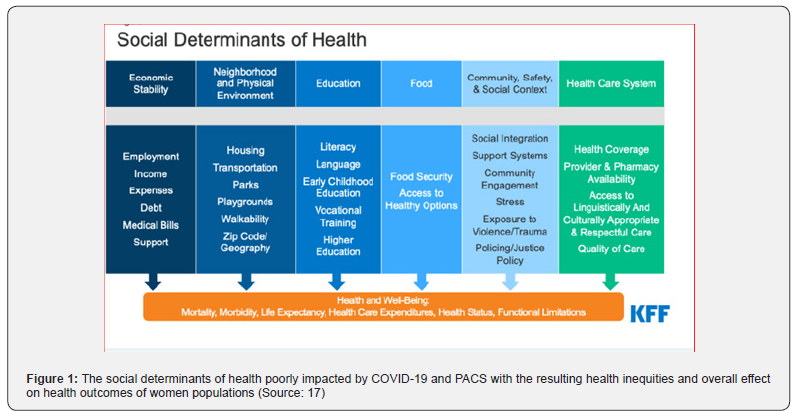
The COVID-19 pandemic and the now evolving PACS public health issue have both increased and further and exposed the already existing health inequities faced by the global women population and it shows the urgent need to work on providing to provider gender specific programs and initiatives designed to specifically address the disproportionate impact on females. This evidence-based review examines the dual impact of the COVID-19 pandemic and emerging PACS and their link to the social determinants of health and deepening degree of health inequities on the global female or women population. The findings presented in this research study are compiled from a rapid systematic review of published world-wide evidence.
- Review Article
- Summary
- Social Determinants of Health
- The Causal Association Between the COVID-19 Pandemic, PACS, Social Determinants of Health and Impact on Gender Based Health Inequities in the Global Women Population
- Links Of COVID-19 Pandemic, PACS and Their Poor Impact Resulting in Two Major Health Inequities Namely Poverty and Deprivation & Low Paid Essential Workers:
- Covid-19 Pandemic, The Subsequent PACS Healthcare Issues and Their Cumulative Effects of Greater Economic Shock on The Global Women Population:
- Overall Implications of the Findings of This Systematic Literature Review in Terms of Improving the Global Women’s Population:
- Conclusion
- Acknowledgment
- References
The Causal Association Between the COVID-19 Pandemic, PACS, Social Determinants of Health and Impact on Gender Based Health Inequities in the Global Women Population
As observed in the COVID-19 global pandemic as well as previous public health crisis scenarios (like the 1918 Spanish influenza pandemic and the H1N1 outbreak of 2009), the effect on different population groups is not uniform [10]. In the case of the global women or female population, the existing inequalities in the social determinants of health were further highlighted by the COVID-19 pandemic, and at present the evolving PACS issues have caused significant impact on these health inequities with poor COVID-19 health outcomes [8,16,17]. The main link to this deepening gap of health inequities on the global women population is partially proliferating because of the below normal ability to comply with optimal social determinants of health. These include the inability of the female population to comply to prescribed COVID-19 public healthcare or social measures that mitigate viral transmission like social distancing, washing or sanitizing hands, adequate usage of face masks, having to still go to work (due to financial stress) and the forced exposure to the COVID-19 infection [3, 5, 6, 8, 17].
A rapid assessment of published literature in this field has shown the emergence of a few key themes and factors that have interlinked the disproportionate effects of the COVID-19 pandemic, the emerging public health issues of PACS and the effect both of these factors have had on exacerbating existing health inequities as well as access to the social determinants of health. This in turn has resulted in poor overall health status and outcomes in the global women or female population. The findings of this qualitative review have been divided according to identified themes and are present below:
High Risk Occupations and Hazardous Work Conditions
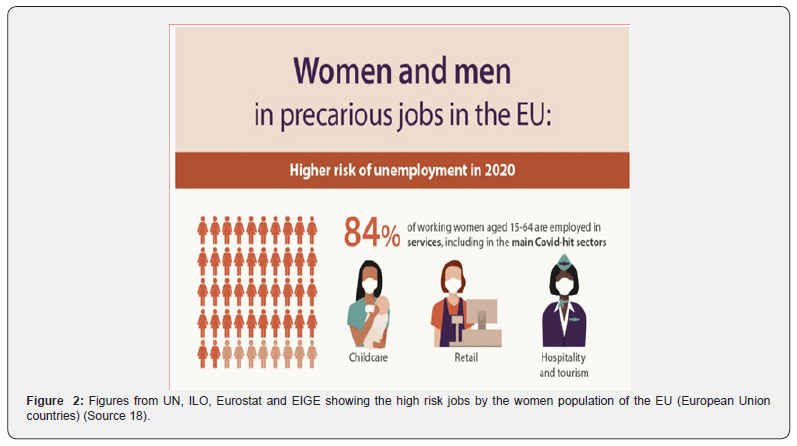
On a global scale, the women population make up more than 70-75% of the work force staff in the fields of healthcare as well as social work [2, 5, 7, 8]. In most countries, the frontline working staffs is made up most of females (see Figure 2 below showing USA figures) [2] and Figure 3 [19]. Women are employed within the lower rungs of employment and are also inadequately paid performed, even though in their role as frontline worker they remain at a higher risk of contracting COVID-19 infections (mainly due to their hazardous work environment and conditions). This is particularly true for the women population of healthcare and frontline workers of lower and middle income nations [2, 5].
In many of these nations, during the COVID-19 pandemic, the women social and community health staff have provided extra services comprising of COVID-19 monitoring and surveillance, follow up care with contact tracing, the immediate quarantine or isolation of infected people and provision of training for self-management of COVID-19 infections at home. Female frontline staff have performed these extra, high risk services alongside their regular duties during the COVID-19 pandemic and yet, even their invaluable work helped in subsidizing global public healthcare systems, they have received poor pay for their services and in many countries, they carried out these high risk COVID-19 services without being given sufficient PPE (personal protective equipment [2, 5, 8, 10, 17].
Figures released by validated international organizations have show how women populations in many countries work in higher percentages in high risk COVID-19 linked jobs and have as a result shown higher rates of COVID-19 infections and now subsequent higher presentation of sequelae with PACS (see Figure 4 above) [19]. Since a higher percentage of frontline workers who were female represented more cases of COVID-19 infections, this equally translated into a higher numbers of women being adversely impacted by both PACS and the socio-economic determinants of health. Thus has lead to an overall increase in the global rates of COVID-19 associated poor health outcomes in the women population [5, 8, 16, 18].
- Review Article
- Summary
- Social Determinants of Health
- The Causal Association Between the COVID-19 Pandemic, PACS, Social Determinants of Health and Impact on Gender Based Health Inequities in the Global Women Population
- Links Of COVID-19 Pandemic, PACS and Their Poor Impact Resulting in Two Major Health Inequities Namely Poverty and Deprivation & Low Paid Essential Workers:
- Covid-19 Pandemic, The Subsequent PACS Healthcare Issues and Their Cumulative Effects of Greater Economic Shock on The Global Women Population:
- Overall Implications of the Findings of This Systematic Literature Review in Terms of Improving the Global Women’s Population:
- Conclusion
- Acknowledgment
- References
Links Of COVID-19 Pandemic, PACS and Their Poor Impact Resulting in Two Major Health Inequities Namely Poverty and Deprivation & Low Paid Essential Workers:
Also these high risk frontline female workers also have an added dimension in terms of caregiver roles to play at home as compared to employed men (Figure 5 below) [2]. The higher percentage of females that are employed as frontline workers with added caregiver responsibilities is clearly shown in Figure 4 below. This situation arose due to a number of factors. The first underlying factor is because of the vertical and horizontal division in the global labor market [2]. This essentially means that on a global scale women usually have employment in lower paid jobs many of which are related to their traditional social function of “care” in most socio-cultural scenarios [18].
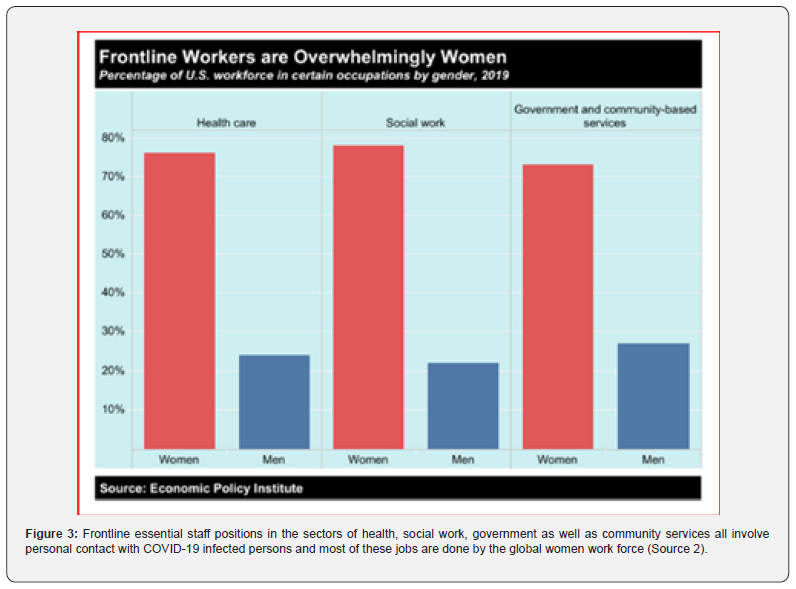
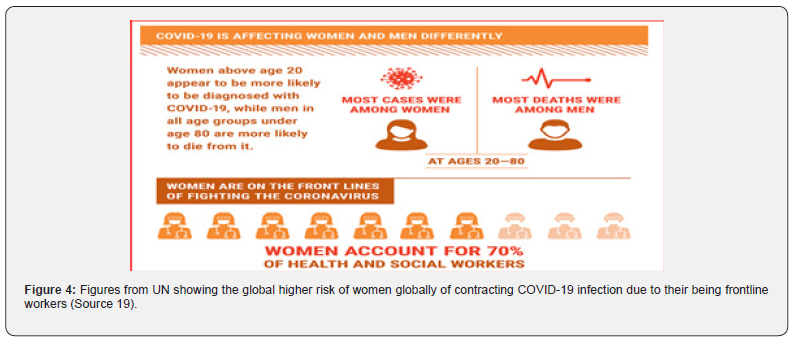
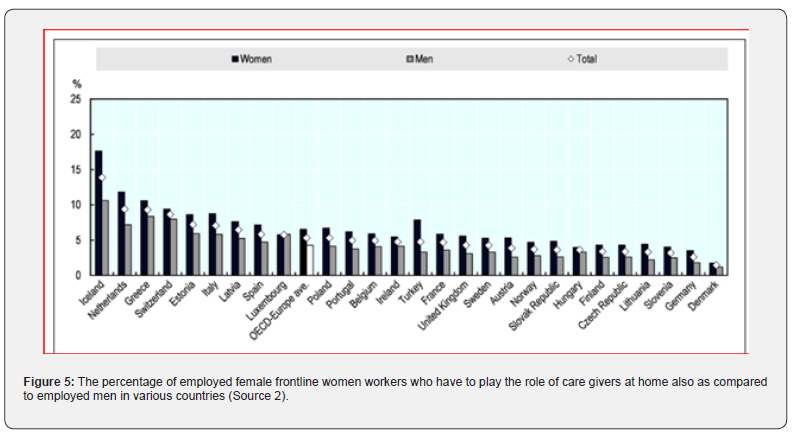
The same jobs have traditionally been termed as being “lower skilled” so as to validate the poor pay scales given to the high percentage of women employed within these frontline healthcare services as well as social service jobs. Therefore, the global women population continues to have a disproportionate part within frontline health and social care jobs, they also continue to give care in home settings with a higher level of responsibilities as compared to employed men [2].
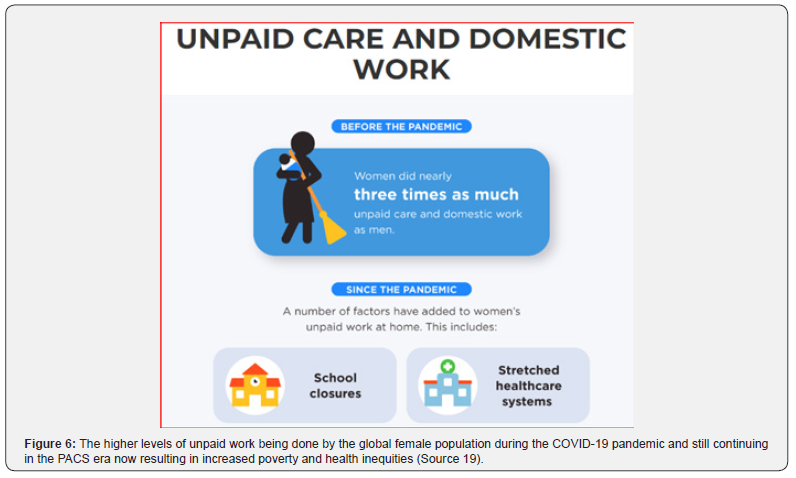
The global economy and routines of maintaining everyday needs in human life are totally dependent on the invisible and mostly unpaid labor of women as well as girls in all age groups [8, 19]. Even before the COVID-19 pandemic and the resulting PACS public health crisis had a poor effect on the social determinants of women’s health, it was a documented fact that the global female population did thrice as much unpaid care giving with household chores as compared to their male counterparts [8] (see Figure 6 below) [19]. In the COVID-19 pandemic era, the viral mitigation measures like lockdowns, social distancing norms, and schools being closed caused heavily stressed national healthcare systems. This resulted in a corresponding increase on work demands on women and girls so as to meet up with the basic survival requirements of their family and also providing home healthcare for the elderly family members and anyone who fell sick. Global figures show that more than 1.5 billion students were sitting at home during the 2020 COVID-19 lockdowns and traditional gender roles caused the increased work demand for unpaid childcare, domestic chores and higher exposure to family members sick with COVID-19 infections while not being able to do paid jobs [5, 8, 19].
Presently evolving evidence-based findings from UN Women’s rapid gender assessment surveys have shown that currently too, with the emerging PACS health issues, a disproportionately high share of unpaid care work is being done by the global women population. This has had a very significant poor impact on women’s social determinants of health resulting in a very increase in the levels of two main health inequities namely “poverty and deprivation” in women as well as their becoming “low paid essential workers” globally. Surveys report that the amount of unpaid work and care continues to become more and has to be combined with their paid jobs [19]. Within lower socio-economic settings in many countries like slums and low cost housing initiative, there is a very high density of population so social distancing is just not possible. In keeping with traditional roles, women have to fetch clean drinking water at extremely crowded community sources and this places them at a high risk for contracting the COVID-19 infection. These issues are very prevalent in rural settings wherein women have the responsibility of fetching water, gathering firewood and even buying or sourcing food rations for the family from crowded village centers. This limits their capabilities to take on paid jobs especially those that can easily be done remotely. There is also a serious lack of childcare support facilities of arrangement for urban frontline and essential female workers who as mothers have family care roles to play too [5, 8, 19, 20]. These discriminatory gender specific social norms has resulted in global women populations in most countries doing lots of unpaid work in the COVID-19 and PACS era. Even teenage and adolescent girls residing in poor rural and isolated settings do a range of unpaid work. Documented findings from previous public health crisis’s have shown that the increasing poverty and lack of money result in girls being dropped out from schools and most are not sent back after the crisis is finished became they have been forced to become unpaid care givers or doing low paid essential jobs to contribute to the family’s upkeep [2, 5, 8, 11, 18, 19, 20]. The global women’s population’s unpaid care work is now identifiable as one of the main drivers of health inequities and social inequality as it is directly associated with female wages inequality, lowered levels of income, and a corresponding stress causing overall poor outcomes in terms of recovery from COVID-19, coping with the long term sequelae of PACS, poor physical as well as mental health status [5, 8, 18, 19, 20, 19, 21].
- Review Article
- Summary
- Social Determinants of Health
- The Causal Association Between the COVID-19 Pandemic, PACS, Social Determinants of Health and Impact on Gender Based Health Inequities in the Global Women Population
- Links Of COVID-19 Pandemic, PACS and Their Poor Impact Resulting in Two Major Health Inequities Namely Poverty and Deprivation & Low Paid Essential Workers:
- Covid-19 Pandemic, The Subsequent PACS Healthcare Issues and Their Cumulative Effects of Greater Economic Shock on The Global Women Population:
- Overall Implications of the Findings of This Systematic Literature Review in Terms of Improving the Global Women’s Population:
- Conclusion
- Acknowledgment
- References
Covid-19 Pandemic, The Subsequent PACS Healthcare Issues and Their Cumulative Effects of Greater Economic Shock on The Global Women Population:
Almost 42% of the global population of employed women have jobs within sectors which were severely impacted in the COVID-19 pandemic and this resulted to a significant economic shock due to decrease or loss of their income [2, 19, 22, 23]. The affected sectors are the informal sector, arts, the field of entertainment as well as domestic services (see Figure 7 below) [2]. The International Labour Organisation has documented that out of the 73% of domestic workers that were at risk of loss of jobs, 68% were women migrant workers [2,19]. During the COVID-19 pandemic, the rate of women’s employment decreased in even developed countries like Canada, Colombia, and the United States [2, 7, 8, 19].
Due to the COVID-19 pandemic and the presently evolving PACS public health crises that have had significant poor outcomes on the global women’s populations, in every country women and girls have been harder hit by the economic effects of these two factors [5, 16- 19]. Even before the COVID-19 pandemic, on a global scale, women were earning less and saving far less as compared to employed men. Furthermore, women make up the major percentage of single-parent homes and as seen in the sections above in this review, women disproportionately have precarious high risk jobs as well as insecure ones that are part of the global informal economic service sectors, most of which have very little job security and virtually no social protections (see Figure 7 above) [18, 19]. As a combined result of the COVID-19 pandemic’s economic impact, poor health due to manifestation of sequelae of PACs and long term issues like pain, fatigue, brain fog, women have suffered a higher degree of economic shocks as compared to men [19]. In several households, school closures and social distancing measures resulted in more unpaid care and domestic workload for girls and women at home. This further decreased their capacity of taking on paid work or striking a balance between unpaid care and paid jobs [18, 19, 22, 23].
This issue of increasing economic instability for the women’s population was more evident in developing economies, wherein a high percentage of women employed within the informal sectors had little to none in terms of social protection, robust health insurance, paid COVID-19 and PACS related sick leave and this resulted in significantly higher levels of unemployment for the global female population. In global regions like the SUB-Saharan Africa, almost 92% of employed females work in the informal economy in contrast to 86% of men [18, 19, 24].
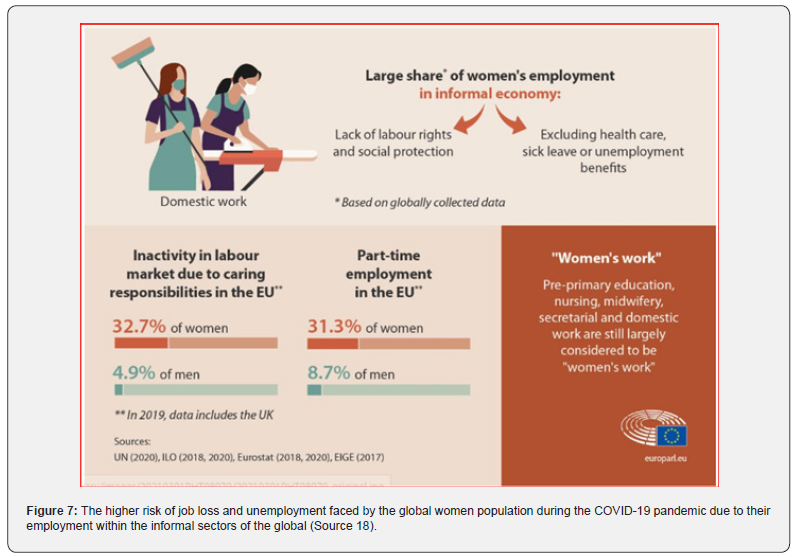
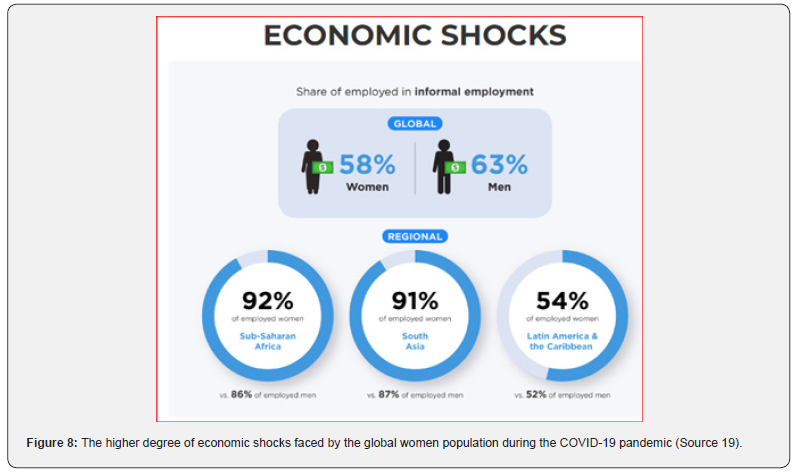
As a result of the mixed disastrous impacts of the COVID-19 pandemic, the long term effects of PACs and their exacerbation of the socio-economic determinants of women’s health, it has been projected there is going to be a prolonged dip in women’s incomes as well as labour force participation. As a result of the COVID-19 pandemic, it has been estimated that informal female workers lost approximately 60& of their total income globally: 81% within the sub-Saharan Africa and Latin American regions while, 70% in the EU and Central Asia with 22% being accounted for in the Asia and the Pacific global regions (see Figure 8 above) [18, 19, 24].
The ILO (International Labor Organization) has projected that as the economic fallout of COVId-19 and subsequently PACS continues, global unemployment is set to go as high as 5.3 million (“lower” scenario) or 24.7 million (“high” scenario) from the previously recorded 188 million in 2019. This is in large due to the COVID-19 pandemic’s effect on the worldwide GDP growth. Women frontline as well as informal workers, female migrants and girls are part of the poorest in global populations and very susceptible to getting infected by COVID-19 as well as loss of jobs. As shown by UN Women surveys from Asia and the Pacific, more females continue to lose their livelihoods rapidly as compared to men and still have limited options to earn income [19, 24]. In USA, women’s unemployment went up from 2.7 million to 11.5 million during the COVID-19 pandemic as per the figures provided by U.S. Bureau of Labor Statistics. From the employment data collected by UN Women, in 26 of 33 countries within even traditionally male dominated employment fields including manufacturing, women continue to fill in insecure or unprotected jobs [19, 24].
The latest economic projection by sex and age made by use of the International Futures Model initiated by UN Women and UNDP project that out of the estimated 100 million people globally pushed into poverty and reduced access to the social determinants of health almost 60 million are women and girls. This effect that takes into account the downward revisions in worldwide economic growth will become worse if gender specific crisis control measures are not put in place for normalization of economic activities to start. It has also been stated that due to increase in the care demands made on women, the slow economic recovery, higher female unemployment rate (because of factors like the economic depression, decreased national public as well as private budgets for sectors like education and childcare) the global women’s population might totally exit from future labor markets [19, 24]. Some specific global regions show more economic shocks from these factors as affected groups are the 54% of the world’s poor females like in the sub-Saharan Africa. This figure is set to rise to 63% by the year 2030. The more worrisome fact is that due to the severe impacts of the COVID-19 pandemic, deteriorating social determinants of health and the evolving present PACs issue, global women’s populations in regions of Central and Southern Asia (these areas had made highly significant progress in poverty eradication and improvement in overall women’s health prior to the pandemic), will now have a corresponding 32% increase in poverty levels as compared to the formerly projected rate of 29% [19, 24]. At present, a gender-based poverty gap in the 25 to 34 years age group is already seen in 75 of the 131 low as well as mid-income nations. Amongst these nations, 8 including Bhutan, Costa Rica, Dominican Republic, Ecuador, Gabon, Guyana, Indonesia, and Nicaragua were set to eradicate this gender-based poverty by the year 2030. However, if no gender specific, women oriented measures and global policies are not stringently applied to counter the disproportionate effect of the COVID-19 pandemic and PACS for mitigation of women’s further impoverishment, the data shows that another 59 nations would require another 72 years to eradicate the resulting gender poverty gaps [19, 24].
- Review Article
- Summary
- Social Determinants of Health
- The Causal Association Between the COVID-19 Pandemic, PACS, Social Determinants of Health and Impact on Gender Based Health Inequities in the Global Women Population
- Links Of COVID-19 Pandemic, PACS and Their Poor Impact Resulting in Two Major Health Inequities Namely Poverty and Deprivation & Low Paid Essential Workers:
- Covid-19 Pandemic, The Subsequent PACS Healthcare Issues and Their Cumulative Effects of Greater Economic Shock on The Global Women Population:
- Overall Implications of the Findings of This Systematic Literature Review in Terms of Improving the Global Women’s Population:
- Conclusion
- Acknowledgment
- References
Overall Implications of the Findings of This Systematic Literature Review in Terms of Improving the Global Women’s Population:
The COVID-19 pandemic, hospitalization and increasing healthcare issues due to PACS have been felt disproportionately more by the global women’s population in every country. This varied range of health inequities and economic shocks have been driven by the widening gap of created inequalities in the social determinants of health experienced by women during the COVID-19 pandemic. It has also been documented by several research studies that women seem to be more susceptible to the developments of sequelae of PACS and the corresponding propensity for long term development of harmful health issues from long COVID-19 infections [3-5, 16, 20, 21, 25- 27]. The resulting health inequities seen in the global women’s population are mostly linked by social determinants of health overlapping with a few biological risks (see Figure 9 below). Thus women on a global scale have experienced higher rates of COVID-19, infections, ensuing PACS in the long terms and higher rates of mortality all driven by:
a) Increased poverty and depravation due to economic shocks
b) Being low-paid essential workers
c) Being migrants and informal sector workers
d) Lack of social protection
e) Crowded living conditions
f) Poor protection at workplace and low occupational hazard health standards
g) Inequalities in access to public health systems and healthcare
h) Health inequities created by inequitable access to COVID-19 treatment and vaccination, PACS care
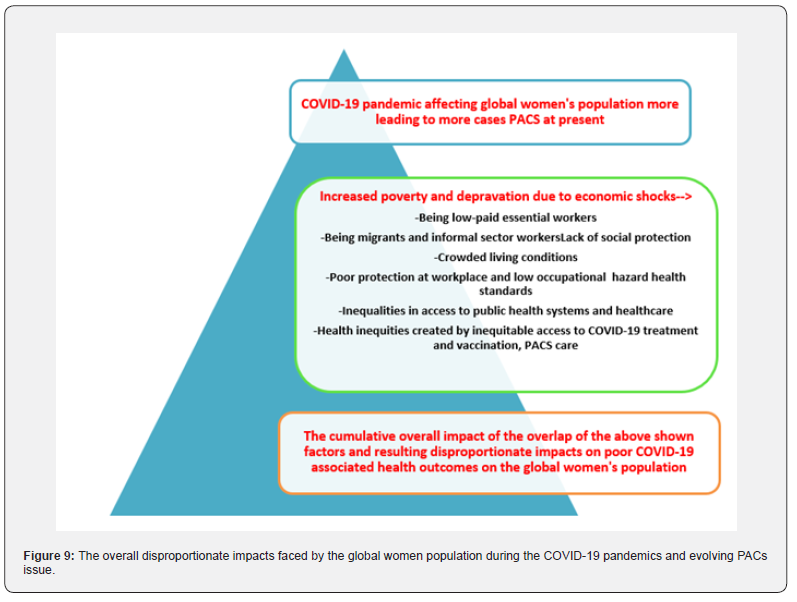
Thus future global COVID-19 recovery initiatives can serve as open spaces for the revaluation of the unpaid “care” provided the women’s population as a functionality which vital to human well being. This identification will require change in political and institutional policies in order for this to be a useful aspect of the post-COVID-19 recovery. There is to need to identify and compensate for the unpaid care rendered by the females of the world as being an integral part of the post COVID-19 recovery and economic systems. The outlined gender specific health inequities and poor COVID-19 based health outcomes are also due to the overlap in gendered work forces and the high representation of women in the global healthcare labor force. Thus the global women’s population experience higher exposure to COVID-19, and have a far larger higher viral load than men, resulting in PACS more often [3-5, 8, 16, 20, 21, 25-27]. We now know the long term health issues that result in higher infection rates and subsequent more frequent presentations with PACS and long COVID-19 health issues [3- 5, 8, 16, 20, 21, 25- 27]. Subsequently, the wider impacts of the COVID-19 pandemic and the presently evolving PACS issue have unequally impacted on the social determinants of women’s health themselves, leading to a vast gap in health inequities. Such unintended and very unjust COVID-19 associated poor health outcomes that have been outline in women show that there is need to pay more attention to the social determinants of health in pandemic preparedness, response and recovery initiatives as long as the COVID-19 pandemic and long term COVID or PACS is still prevalent.
It is of concern to note that, there are limited numbers of research studies that have examined the links between the COVID-19 pandemic, PACS, their impact on the social determinants of women’s health on national and global scale. There is a vast amount of data on this topic that has been accumulated in the last 3 years and the emerging issues in terms of women’s health should make us re-evaluate the way COVID-19 recovery efforts are being shaped and the urgent need to make them gender specific. COVID-19 has high-lighted several “blind-spots” in global public and health policies that are unfortunately gender based. We can therefore see the need for further impact assessments of the COVID-19 pandemic on women and shape future actions to remedy the “unintended” consequences that have a disproportionate harmful impact on the global women’s population.
- Review Article
- Summary
- Social Determinants of Health
- The Causal Association Between the COVID-19 Pandemic, PACS, Social Determinants of Health and Impact on Gender Based Health Inequities in the Global Women Population
- Links Of COVID-19 Pandemic, PACS and Their Poor Impact Resulting in Two Major Health Inequities Namely Poverty and Deprivation & Low Paid Essential Workers:
- Covid-19 Pandemic, The Subsequent PACS Healthcare Issues and Their Cumulative Effects of Greater Economic Shock on The Global Women Population:
- Overall Implications of the Findings of This Systematic Literature Review in Terms of Improving the Global Women’s Population:
- Conclusion
- Acknowledgment
- References
Conclusion
An unprecedented shock to the global society and economy was given by the COVID-19 pandemic. The unequal impact felt by the global women’s population once again stress the importance of our dependence on women both as frontline workers, in the informal labor sector, skilled working sectors and particularly in households. Women have experienced significant and simultaneous exposure to inequalities in the social determinants of health due to COVID-19 in every aspect of life ranging from poor health outcomes to economic shocks. During healthcare pandemics and crisis, as resources become stressed and healthcare and other institutional services become scarce, women and girls bear the massive, disproportionately harmful impacts that have long term consequences. Even hard-fought gains like poverty eradication for women are now being set back. for women’s rights are also under threat. There are significant health and gender inequities linked to the COVID-19 pandemic and the emerging PACS public health issue. There is need to remedy existing health inequities and create a resilient world in which the interests of women are given the attention they need in the recovery phase. This paper has summarized some of the key drivers of disproportionate poor impact of the COVID-19 pandemic, the evolving PACS public health issues, their links to the social determinants of women’s health and the resulting health inequities being suffered by the global women population. As countries rebuild COVID-19 impacted healthcare and distressed national economies, this global crisis has given us the option to identify and decrease the resulting health inequities faced by women and to compensate as well as redistribute unpaid care work forever in the future.
- Review Article
- Summary
- Social Determinants of Health
- The Causal Association Between the COVID-19 Pandemic, PACS, Social Determinants of Health and Impact on Gender Based Health Inequities in the Global Women Population
- Links Of COVID-19 Pandemic, PACS and Their Poor Impact Resulting in Two Major Health Inequities Namely Poverty and Deprivation & Low Paid Essential Workers:
- Covid-19 Pandemic, The Subsequent PACS Healthcare Issues and Their Cumulative Effects of Greater Economic Shock on The Global Women Population:
- Overall Implications of the Findings of This Systematic Literature Review in Terms of Improving the Global Women’s Population:
- Conclusion
- Acknowledgment
- References
Acknowledgment
I thank Mr. Bharat Sharma for his extended support in data collection and authentication of the validity of the sources during this study.
- Review Article
- Summary
- Social Determinants of Health
- The Causal Association Between the COVID-19 Pandemic, PACS, Social Determinants of Health and Impact on Gender Based Health Inequities in the Global Women Population
- Links Of COVID-19 Pandemic, PACS and Their Poor Impact Resulting in Two Major Health Inequities Namely Poverty and Deprivation & Low Paid Essential Workers:
- Covid-19 Pandemic, The Subsequent PACS Healthcare Issues and Their Cumulative Effects of Greater Economic Shock on The Global Women Population:
- Overall Implications of the Findings of This Systematic Literature Review in Terms of Improving the Global Women’s Population:
- Conclusion
- Acknowledgment
- References
References
- Ministry of Health and Family Welfare Government of India (2023) Information Regarding COVID-19 Vaccine - MoHFW.
- Guerrina R, Borisch B, Callahan LF, Howick J, Reginster JY, et al. (2021) Health and gender inequalities of the COVID-19 pandemic: adverse impacts on women's health, wealth and social welfare. Front Glob Womens Health 2: 670310.
- Sharma B (2022) A New Phenomenon: Post-Acute COVID-19 Syndrome. Int J Pul & Res Sci 6(2): 1-7.
- Gebhard CE, Sütsch C, Bengs S, Deforth M, Buehler KP, et al. (2021) Understanding the impact of sociocultural gender on post-acute sequelae of COVID-19: A Bayesian approach. MedRxiv 21259757, University of Zurich, Switzerland.
- Sharma B (2022) A Review: The Global Impact of the COVID-19 Pandemic on Women’s Health. J Gynecol Women’s Health 23(3): 1-6.
- The World Health Organization (2023) Coronavirus disease (COVID-19): Post COVID-19 condition.
- Paremoer L, Nandi S, Serag H, Baum F (2021) Covid-19 pandemic and the social determinants of health. BMJ 372: 372:n129.
- World Health Organization (2021) COVID-19 and the social determinants of health and health equity: Evidence brief.
- Solar O, Valentine N, Castedo A, Brandt GS, Sathyandran J, et al. (2022) Action on the social determinants for advancing health equity in the time of COVID-19: perspectives of actors engaged in a WHO Special Initiative. International Journal for Equity in Health 21(3): 1-10.
- Morante-García W, Zapata-Boluda RM, García-González J, Campuzano-Cuadrado P, Calvillo C, et al. (2022) Influence of social determinants of health on COVID-19 infection in socially vulnerable groups. Int J Environ Res Public Health 19(3): 1294.
- Rollston R, Galea S (2020) COVID-19 and the social determinants of health. American Journal of Health Promotion 34(6): 687-689.
- Sudre CH, Murray B, Varsavsky T, Graham MS, Penfold RS, et al. (2021) Attributes and predictors of long COVID. Nat Med 27(4): 626-631.
- Huang C, Huang L, Wang Y, Li X, Ren L, et al. (2021) 6-month consequences of COVID-19 in patients discharged from hospital: a cohort study. The Lancet 397(10270): 220-232.
- Ayoubkhani D, Pawelek P (2021) Prevalence of ongoing symptoms following coronavirus (COVID-19) infection in the UK: 1 April 2021. Off Natl Stat, pp. 1-16.
- Kozak R, Armstrong SM, Salvant E, Ritzker C, Feld J, et al. (2021) Recognition of long-COVID-19 patients in a Canadian tertiary hospital setting: a retrospective analysis of their clinical and laboratory characteristics. Pathogens 10(10): 1246.
- Fernández-de-Las-Peñas C, Martín-Guerrero JD, Pellicer-Valero ÓJ, Navarro-Pardo E, Gómez-Mayordomo V, et al. (2022) Female sex is a risk factor associated with long-term post-COVID related-symptoms but not with COVID-19 symptoms: the LONG-COVID-EXP-CM multicenter study. J Clin Med 11(2): 413.
- Kaiser Family Foundation Brief (2022) Tracking Social Determinants of Health During the COVID-19 Pandemic.
- European Parliament (2021) Understanding Covid-19's impact on women (infographics).
- United Nations (UN) (2023) How COVID-19 impacts women and girls.
- Mack JA, Voss EA, Rusu R, Hernandez MC, Hernandez-Diaz S, et al. (2022) Social determinants of health associated with COVID-19 severity during pregnancy: a multinational cohort study (in the International Registry of Coronavirus Exposure in Pregnancy). BMC Public Health 22(1): 2256.
- Aghaei A, Zhang R, Taylor S, Tam CC, Yang CH, et al. (2022) Social life of females with persistent COVID-19 symptoms: a qualitative study. Int J Environ Res Public Health 19(15): 9076.
- Ranasinghe PD, Zhou A (2023) Women physicians and the COVID-19 pandemic: gender-based impacts and potential interventions. Ann Med 55(1): 319-324.
- Rudroff T, Workman CD, Bryant AD (2022) Potential factors that contribute to post-COVID-19 fatigue in women. Brain sciences 12(5): 556.
- UN Women (2020) GENDER AND COVID-19, Surveys show that COVID-19 has gendered effects in Asia and the Pacific.
- Domosławska-Żylińska K, Krysińska-Pisarek M, Włodarczyk D (2023) Gender-Specificity of Fatigue and Concerns Related to the COVID-19 Pandemic-A Report on the Polish Population. Int J Environ Res Public Health 20(7): 5407.
- Haneef R, Fayad M, Fouillet A, Sommen C, Bonaldi C, et al. (2023) Direct impact of COVID-19 by estimating disability-adjusted life years at national level in France in 2020. Plos one 18(1): e0280990.
- Iglesias Martínez E, Roces García J, Jiménez Arberas E, Llosa JA (2022) Difference between Impacts of COVID-19 on Women and Men’s Psychological, Social, Vulnerable Work Situations, and Economic Well-Being. Int J Environ Res Public Health 19(14): 8849.






























